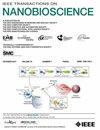A High Sensitive Nanomaterial Coated Side Polished Fiber Sensor for Detection of Cardiac Troponin I Antibody
IF 4.4
4区 生物学
Q1 BIOCHEMICAL RESEARCH METHODS
引用次数: 0
Abstract
The advent of evanescent field based fiber optic biosensor and advancements in nanotechnology has create an excellent opportunity in label-free detection of biomarkers which plays vital role in the early, rapid and accurate diagnosis of acute diseases. In this work, we demonstrate a high sensitive Molybdenum Tungsten Disulfide (MoWS2) coated side polished fiber (SPF) biosensor for accurate and early diagnosis of cardio vascular disease (CVD). The Cardiac Troponins I (cTnI) is identified as a biomarker of interest for early and rapid diagnosis of CVD. The proposed SPF biosensor exhibits surface plasmonic resonance (SPR) detection due to the evanescent field interaction between MoWS2 nano coated side polished region and anti-CTnI. The proposed SPF biosensor possess the high sensitivity of 82% to detect the cTnI antibody with a limit of detection (LOD) about 17.5 pg/mL. The peak SPR shift have been calculated as 61 nm for analyte concentrations of 500 pg/mL Moreover, the proposed SPF biosensor possess the high degree of selectivity and environmental stability to CTnI among three analytes such as CTnI, Estrogen and Glucose. The hydrophobic interactions of MoWS2 and cTnI antibody leads to chemical free biofunctionalization of antibody in the sensing region. Hence, the simulation results shows the surface interaction strength calculated as 1.29 KJ mol−1/nm2 in order to evaluate the hydrophobic interactions. Thus, the proposed optical biosensor is a promising candidate for “point-of-care” testing of CVD disorders and preclinical assessments.一种用于检测心肌肌钙蛋白I抗体的高灵敏度纳米材料涂层侧抛光纤维传感器。
瞬变场光纤生物传感器的出现和纳米技术的进步为生物标志物的无标记检测创造了绝佳的机会,这对急性疾病的早期、快速和准确诊断起着至关重要的作用。在这项工作中,我们展示了一种高灵敏度的二硫化钼(MoWS2)涂层侧抛光纤维(SPF)生物传感器,用于准确和早期诊断心血管疾病(CVD)。心脏肌钙蛋白I (cTnI)被认为是CVD早期和快速诊断的生物标志物。由于MoWS2纳米涂层侧抛光区与抗ctni之间的瞬变场相互作用,该SPF生物传感器表现出表面等离子体共振(SPR)检测。SPF型生物传感器检测cTnI抗体的灵敏度高达82%,检测限(LOD)约为17.5 pg/mL。当分析物浓度为500 pg/mL时,SPR峰值位移为61 nm。此外,SPF生物传感器在CTnI、雌激素和葡萄糖三种分析物中对CTnI具有高度的选择性和环境稳定性。MoWS2和cTnI抗体的疏水相互作用导致抗体在感应区无化学生物功能化。因此,模拟结果表明,用于评价疏水相互作用的表面相互作用强度计算为1.29 KJ mol-1/nm2。因此,提出的光学生物传感器是CVD疾病“护理点”测试和临床前评估的有希望的候选者。
本文章由计算机程序翻译,如有差异,请以英文原文为准。
求助全文
约1分钟内获得全文
求助全文
来源期刊

IEEE Transactions on NanoBioscience
工程技术-纳米科技
CiteScore
7.00
自引率
5.10%
发文量
197
审稿时长
>12 weeks
期刊介绍:
The IEEE Transactions on NanoBioscience reports on original, innovative and interdisciplinary work on all aspects of molecular systems, cellular systems, and tissues (including molecular electronics). Topics covered in the journal focus on a broad spectrum of aspects, both on foundations and on applications. Specifically, methods and techniques, experimental aspects, design and implementation, instrumentation and laboratory equipment, clinical aspects, hardware and software data acquisition and analysis and computer based modelling are covered (based on traditional or high performance computing - parallel computers or computer networks).
 求助内容:
求助内容: 应助结果提醒方式:
应助结果提醒方式:


